Struggling to build stable APIs?
Inconsistent design leads to frustrating bugs, slows down your team, and creates a nightmare for anyone trying to integrate with your system.
This not only wastes valuable engineering hours but also undermines your product’s reliability and makes it incredibly difficult to scale your services effectively.
Without a standardized design process, your teams operate in silos. This leads to inconsistent endpoints and a poor developer experience for your partners and customers.
But the right tools can solve this by helping you design and validate APIs before a single line of code is ever written.
In this guide, I’ll review the best API design tools available today. We’ll look at options that help you create consistent, well-documented, and error-free APIs.
You’ll learn how to choose a solution that streamlines your workflow, improves collaboration, and helps your team build better APIs, faster.
Let’s get started.
Quick Summary:
| # | Software | Rating | Best For |
|---|---|---|---|
| 1 | Astera Software → | Teams streamlining data workflows | |
| 2 | Postman → | Growing SaaS companies | |
| 3 | MuleSoft → | Large enterprises | |
| 4 | FastAPI → | Technical leads & API designers | |
| 5 | Swagger → | Growing SaaS companies |
1. Astera Software
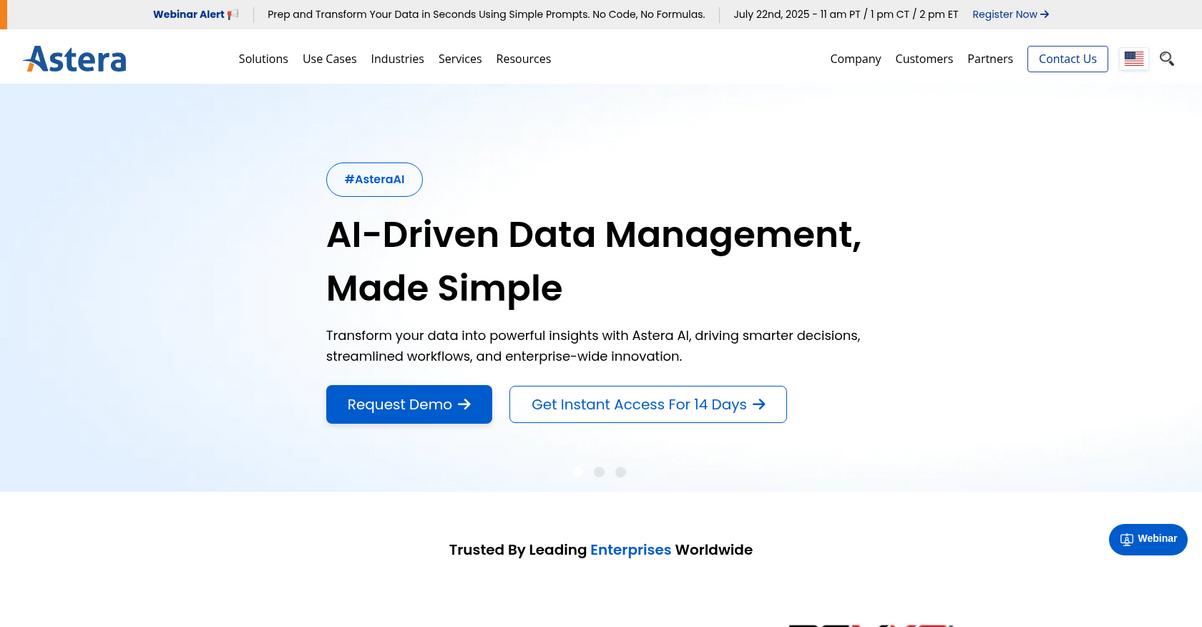
Struggling with API design complexity and integration headaches?
Astera Software offers a drag-and-drop visual builder, allowing you to design, test, and launch intelligent AI agents effortlessly.
This means you can streamline your data management with AI-powered solutions, reducing manual effort and potential errors in your API workflows.
Ready for simplified data management?
Astera helps you achieve more by transforming your data into powerful insights, driving smarter decisions, and streamlining your workflows. This includes automating data extraction from various unstructured documents like invoices and financial reports in seconds, a significant time-saver for your team. Additionally, you can build customized data integration pipelines using AI, pre-built connectors, and robust validation features within a no-code environment. This allows for seamless ETL/ELT processes and connection to over 50 databases, files, APIs, and cloud services, along with code-free API development and lifecycle management. The result is a substantial boost in operational efficiency and faster time to market.
Achieve more with your data today.
While we’re discussing operational efficiency, my article on best PTO tracking software can help you streamline employee leave management.
Key features:
- AI-powered Data Management: Prepare your data for analysis using simple, chat-based instructions, and design, test, and launch AI agents effortlessly with a drag-and-drop visual builder.
- Customized Data Integration Pipelines: Quickly create and visualize data pipelines in a no-code environment, leveraging AI, pre-built connectors, transformations, and validation features, including code-free API development.
- Unstructured Data Extraction: Automate data extraction from various file types, including invoices and financial reports, build AI workflows, and validate data for accuracy with built-in tools.
Learn more about Astera Software features, pricing, & alternatives →
Verdict: Astera Software excels in simplifying complex data management with its AI-driven capabilities and no-code interface, making it one of the best API design tools for teams seeking to streamline development. Its ability to automate unstructured data extraction and offer robust data integration pipelines ensures precise, reliable data and reduced operational costs.
2. Postman
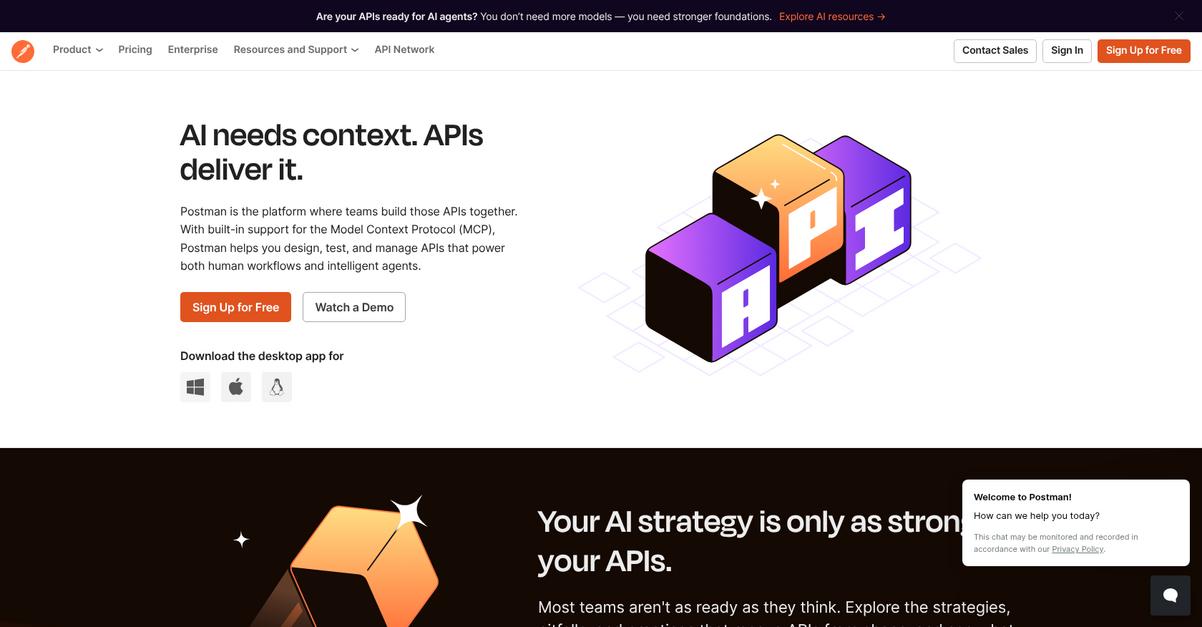
Struggling with API design complexity and team collaboration?
Postman tackles these challenges head-on, offering a platform where your teams can build, test, and manage APIs together. This means you can prototype, document, and demo all your APIs in one centralized location.
The platform helps you streamline API development, fostering a team-oriented approach to API creation. This facilitates faster initial API calls and improves onboarding for your developers.
How can your team achieve seamless API workflows?
Postman’s platform centralizes API development, enabling real-time collaboration that transforms individual efforts into a unified team sport. Your developers can quickly start testing and building workflows.
The Collections feature in Postman expedites self-serve API consumption across your organization, allowing developers to execute, test, and interact with APIs in seconds. This drastically reduces the duplication of work for your teams.
Additionally, Postman’s AI agent, Postbot, helps you write test scripts from scratch, generate tests for entire collections, or visualize API responses with graphs for better output understanding. This ensures fewer errors and higher-quality APIs.
The result: stable, high-quality APIs scaling with your growth.
Before diving deeper, you might find my analysis of best Azure management tools helpful for broader cloud infrastructure.
Key features:
- Collaborative Workspaces: Organize API collections where changes are seen in real-time, reducing work duplication and enhancing team coordination.
- Automated Documentation: Automatically generate API documentation for faster onboarding, ensuring consistency across teams and stronger partner collaboration.
- AI-Powered Testing: Utilize Postbot to write test scripts, generate full collection tests, and visualize API responses, leading to fewer errors and higher API quality.
Learn more about Postman features, pricing, & alternatives →
Verdict: Postman stands out as one of the best API design tools for growing SaaS companies, empowering your teams to conquer API design complexities. Its collaborative features, automated documentation, and AI-powered testing capabilities streamline development cycles, reduce errors, and ensure your APIs scale efficiently with your business growth.
3. MuleSoft
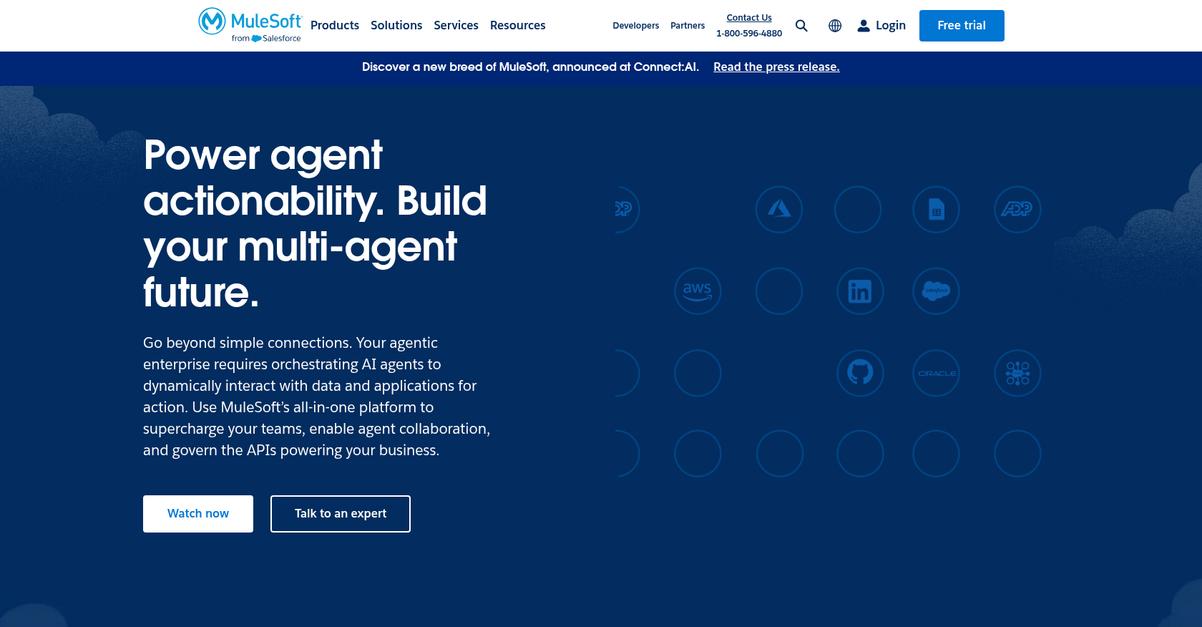
Struggling to manage your complex API ecosystem?
You need a platform that unifies your disparate systems and applications, simplifying even the most intricate integrations.
This means you can connect your data, apps, and devices quickly, empowering you to automate processes and unlock new business capabilities.
Here’s how MuleSoft can help.
MuleSoft provides a unified platform to design, build, and manage your APIs, accelerating digital transformation.
You can rapidly integrate applications and data across your entire enterprise, from on-premises systems to cloud services. This allows for seamless data flow and process automation, enhancing operational efficiency.
Additionally, MuleSoft enables your teams to create reusable API building blocks, fostering agility and reducing development time for future projects. This approach minimizes errors and ensures consistency across all your integrations.
Experience seamless API management.
Before diving deeper, you might find my analysis of best authentication software helpful.
Key features:
- Unified integration platform: Connects data, applications, and devices across your enterprise for comprehensive digital transformation.
- Reusable API building blocks: Enables rapid development and consistent integration across projects, significantly reducing time to market.
- Automated process orchestration: Automates workflows by integrating diverse systems, improving operational efficiency and scalability.
Learn more about MuleSoft features, pricing, & alternatives →
Verdict: MuleSoft positions itself as one of the best API design tools for organizations seeking a unified platform to streamline complex integrations. Its focus on reusable API components and automated processes can help your team reduce errors and accelerate development cycles, aligning perfectly with your need for stable, scalable APIs.
4. FastAPI
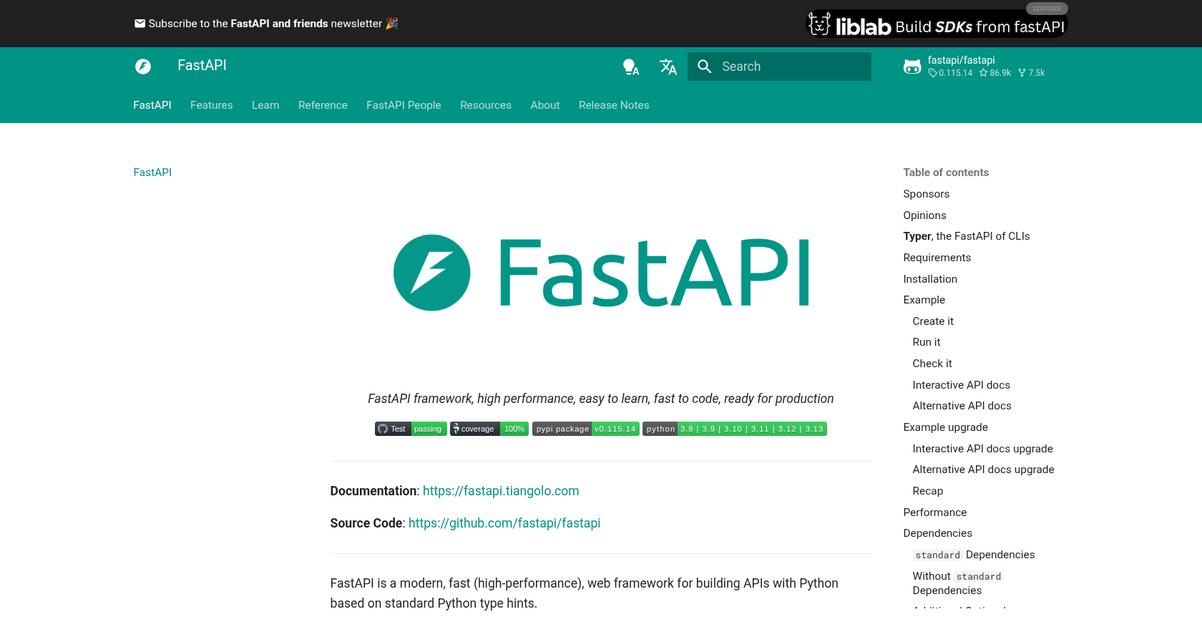
Struggling to build high-performance APIs quickly?
FastAPI offers a modern, high-performance web framework for building APIs with Python, leveraging standard Python type hints. This means you can create robust, production-ready code with automatic interactive documentation.
This addresses the challenge of overwhelming tool choices by providing a clear, standards-based solution for efficient API development. It helps you focus on solving problems rather than deciphering complex tool documentation.
Here’s how it solves that.
FastAPI is designed for intuitive use, providing great editor support with completion everywhere, which reduces debugging time. It promises to increase your feature development speed by about 200% to 300%.
Additionally, this framework helps minimize code duplication with multiple features derived from each parameter declaration, leading to fewer human-induced errors—about 40% reduction, based on internal team tests. It handles validation and conversion of complex JSON objects automatically, saving significant manual effort. Plus, FastAPI is fully compatible with OpenAPI and JSON Schema, ensuring your APIs align with open standards for broader adoption and integration. The result is a streamlined API design and development process.
You get automatic interactive API documentation.
Key features:
- High Performance: Achieves very high performance, on par with NodeJS and Go, making it one of the fastest Python frameworks for your scalable applications.
- Developer Efficiency: Significantly increases the speed of feature development and reduces human-induced errors, improving your team’s productivity and code quality.
- Automatic Documentation & Validation: Provides automatic interactive API documentation (Swagger UI, ReDoc) and robust data validation, simplifying API testing and maintenance.
Learn more about FastAPI features, pricing, & alternatives →
Verdict: FastAPI stands out among the best API design tools by offering a high-performance, Python-based framework that drastically cuts development time and human errors, making it ideal for API designers and technical leads aiming for efficient, scalable, and standards-compliant API solutions.
5. Swagger
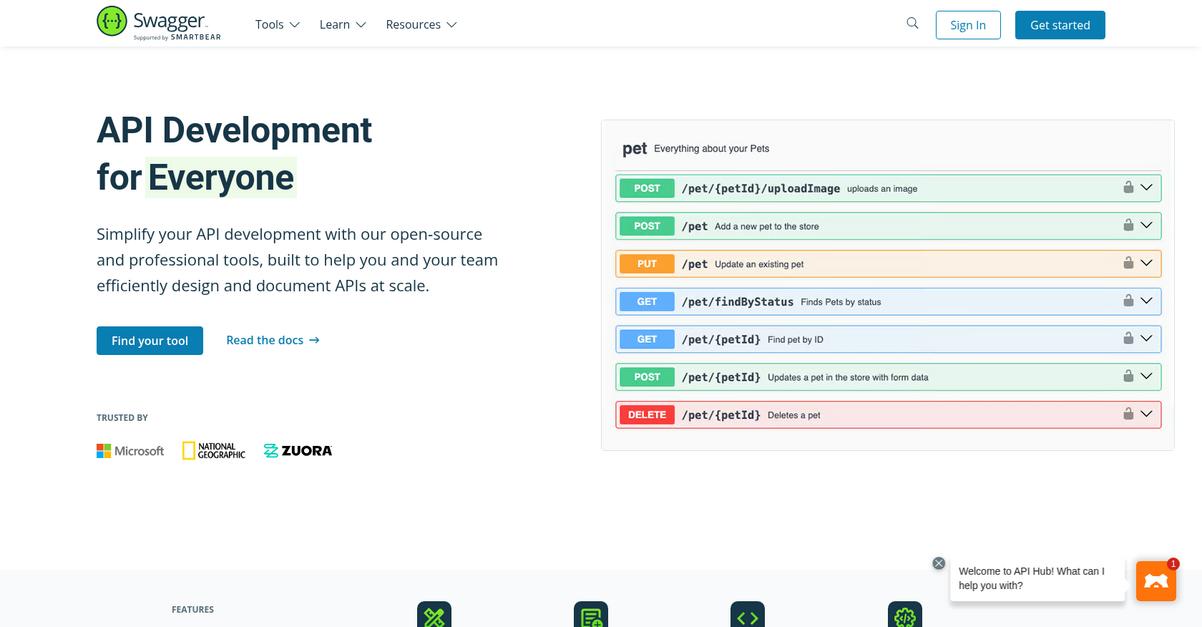
Are you tired of API design complexity?
Swagger offers tools to design, build, and document APIs efficiently. This helps your team overcome choice paralysis and streamline development.
Its focus on OpenAPI and AsyncAPI specifications guides your team through the entire API lifecycle, ensuring quality and consistency in development.
Here’s a solution for you.
Swagger simplifies API development, providing open-source and professional tools for designing and documenting APIs at scale. You can design and model APIs to specification-based standards, which means you avoid integration issues.
You can improve developer experience with interactive API documentation, allowing easy visualization and interaction with API resources. Additionally, you can ensure API quality with scalable, automated testing and block breaking changes with contract testing, streamlining your workflow.
Furthermore, Swagger Codegen generates client libraries and server stubs directly from OpenAPI specifications, and Swagger Editor lets you craft APIs in your browser with real-time feedback. Plus, the API Hub supports teamwork with role-based access controls and effortless integration into your existing systems.
The result is scalable, reliable APIs.
Key features:
- Specification-Driven Design: Leverage OpenAPI and AsyncAPI specifications to guide your API design and documentation, ensuring consistency and seamless development across your team.
- Automated Testing & Documentation: Improve API quality with scalable, automated functional and contract testing, alongside interactive documentation that enhances the developer experience.
- Team Collaboration & Governance: Streamline workflows with advanced collaboration tools, role-based access controls, and features to enforce consistent API design standards across your organization.
Learn more about Swagger features, pricing, & alternatives →
Verdict: Swagger stands out as one of the best API design tools for growing SaaS companies, effectively addressing issues like choice paralysis and integration challenges. Its strong focus on specification-based design, automated testing, and team collaboration ensures your APIs are stable, scalable, and compliant.
6. Stoplight
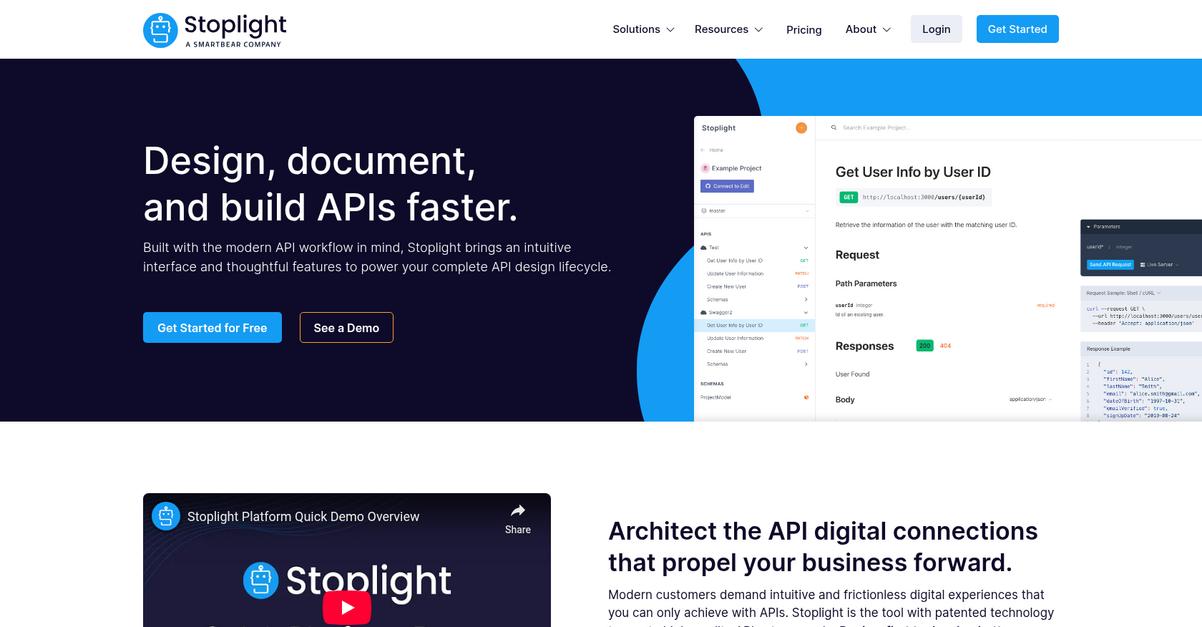
Struggling with fragmented API design workflows?
Stoplight offers an intuitive platform that streamlines your entire API design lifecycle, making development faster and more efficient.
This means you can easily design, document, and build high-quality APIs, avoiding the underbelly of delays and overages that often plague development cycles.
Here’s how to accelerate your API strategy.
Stoplight simplifies API creation with a design-first approach, leveraging patented technology to create high-quality APIs at any scale. It provides visibility into your entire API portfolio, enabling you to design your APIs DRY (Don’t Repeat Yourself). This leads to consistent productivity and allows your developers to work with clear requirements and increased autonomy, optimizing development across teams. Additionally, Stoplight provides robust support through the SmartBear Community, where users collaborate to solve problems and innovate together, ensuring a stronger foundation for your API design and development efforts.
Ready to propel your business forward?
Before diving deeper, you might find my analysis of Best CAM Software helpful.
Key features:
- Complete API design lifecycle: Stoplight offers an intuitive interface to design, document, and build APIs faster, supporting the entire modern API workflow from concept to deployment.
- Design-first and DRY principles: You can architect high-quality APIs at any scale by reusing models and components, ensuring consistency and reducing redundant development efforts.
- Optimized team collaboration: The platform provides clear requirements and streamlined communication, empowering API developers and optimizing workflow across small and large teams.
Learn more about Stoplight features, pricing, & alternatives →
Verdict: If you’re seeking the best API design tools to streamline your development process and reduce errors, Stoplight is an excellent choice. Its design-first approach, coupled with robust collaboration features and support for DRY principles, helps you create high-quality, scalable APIs while minimizing risks and maximizing your return on investment.
7. ReadMe
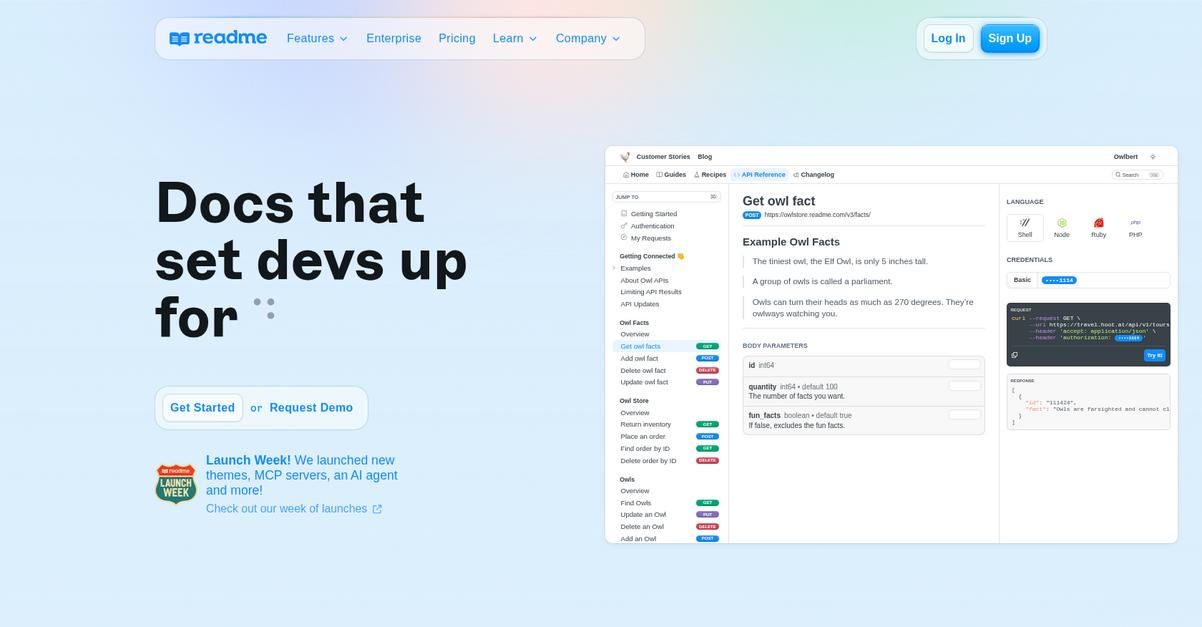
Are you struggling with API documentation overload?
ReadMe offers solutions like versioning, changelogs, and integrated API reference guides directly in your documentation. This means your developers can get up and running quickly.
You can streamline your API development cycles and reduce documentation efforts, allowing your team to focus on building, not explaining, your APIs.
So, how can this help your team?
ReadMe helps you provide everything developers need to make their first API call easily, directly within your documentation. You can allow users to fill out requests, provide API keys, and even let them “Try It” without leaving the docs.
This means you can make it incredibly simple for developers to interact with your API and quickly get to a successful 200 response, whether they’re using Shell, Node, Ruby, or PHP. They can also see their request history and debug recent API calls. Additionally, features like MDX for JSX and Markdown, reusable content, and custom components empower your technical writers and engineers to keep your docs in sync.
Plus, you gain insights into API usage via email, API key, or company, which allows you to understand and assist struggling users. It also enables community-refined docs through suggested edits and provides valuable feedback and doc metrics like page views and quality.
Empower your developers, streamline your workflow.
Speaking of supporting your teams, my guide on best corporate gifting solutions can help you find ways to delight your global workforce and clients.
Key features:
- Interactive API Explorer: Allows developers to make authenticated requests, fill out parameters, and execute API calls directly from your documentation, generating code snippets in 20+ languages.
- Comprehensive Documentation Tools: Includes versioning, changelogs, step-by-step tutorials, custom pages, SEO optimization, and an integrated glossary to ensure your docs are always up-to-date.
- Team Collaboration & Analytics: Supports seamless collaboration between writers and engineers via WYSIWYG or Git-backed docs, offering insights into API usage, request history, and user activity.
Learn more about ReadMe features, pricing, & alternatives →
Verdict: If you’re seeking to streamline API development, enhance collaboration, and create exceptional developer experiences, ReadMe is one of the best API design tools for you. Its focus on interactive documentation, real-time feedback, and comprehensive analytics significantly reduces friction for developers and helps justify your ROI.
8. Apidog
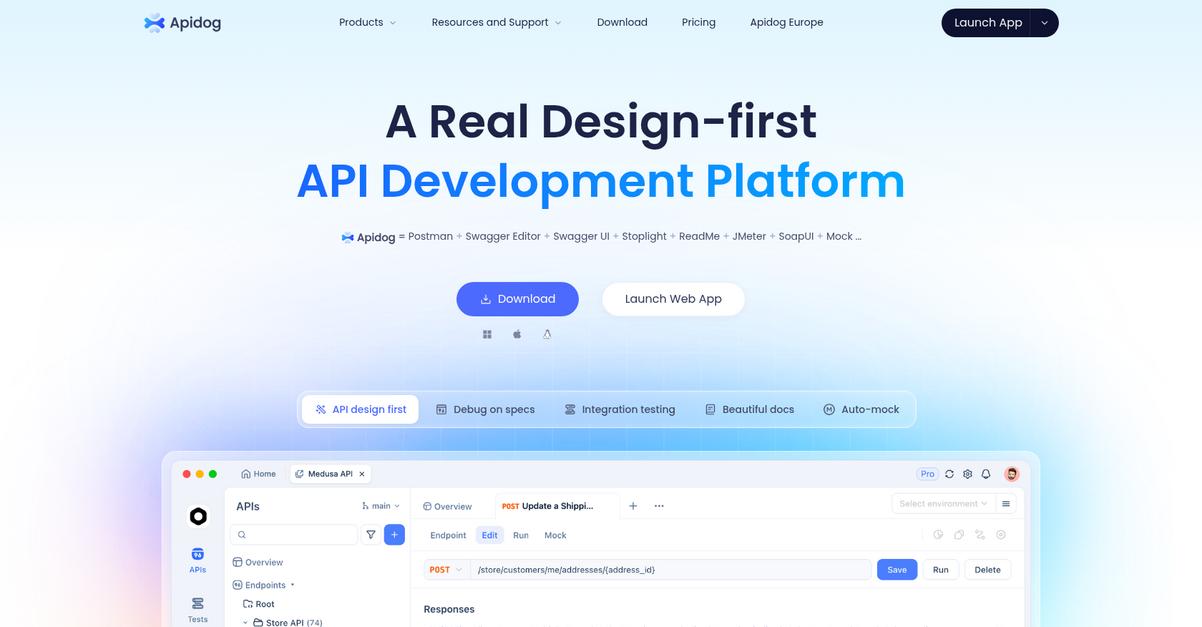
Struggling with fragmented API development workflows?
Apidog brings an all-in-one platform for API design, debugging, testing, mocking, and documentation to solve this.
This means you can effortlessly describe your API as you test it, eliminating redundant tasks and ensuring team unity from design to deployment.
You need a platform that streamlines your entire API lifecycle.
Apidog implements an API Design-first approach, facilitating the effortless synchronization of your API, specifications, and modifications. This means you can create test cases, add assertions visually, and build test scenarios easily, saving countless hours.
You can publish beautiful, interactive API documentation with customizable domains, headers, and layouts. Additionally, Apidog offers a smart mock server that automatically generates data or returns specified data based on requests, even allowing mock scripts to modify returned data, preventing development blockers.
The result is a unified workflow that dramatically reduces errors and speeds up your development cycles, directly addressing your pain points.
If you’re running a SaaS business, you’ll find my guide on best SaaS billing software essential for managing finances.
Key features:
- Design & Develop APIs Faster: Effortlessly describe and test your APIs, generating JSON/XML schemas with a single click and supporting branches for collaborative development.
- Low-code API Testing: Visually generate test cases from APIs, add assertions, and create complex test scenarios with branches and iterations, streamlining your testing process.
- Publish Beautiful Documentations: Share interactive API documentation with ‘try it out’ features, example code, and custom domains, enhancing developer experience and reducing manual effort.
Learn more about Apidog features, pricing, & alternatives →
Verdict: Apidog is an excellent choice among the best API design tools for technical leads at growing SaaS companies. Its all-in-one platform and design-first approach streamlines API development, debugging, and testing, reducing documentation effort. This tool empowers your team to deliver stable, scalable APIs while minimizing errors and aligning with industry standards.
Conclusion
Inconsistent API design creates chaos.
Choosing the right tool from a crowded market is overwhelming. You need a solution that streamlines your workflow without a steep learning curve or hidden costs.
Without a solid tool, your team wastes precious hours on manual validation and bug fixes. This directly impacts your product’s reliability and significantly slows your time to market, undermining any competitive edge.
Here is what I recommend.
After reviewing all the options, Astera Software clearly stands out. Its powerful no-code approach directly solves the complexity and integration headaches that many development teams face today.
What I find most impressive is its AI-powered data management and code-free environment. Using one of the best API design tools like Astera helps you build and launch APIs much faster.
While we’re discussing how to build and launch APIs, my article on best WhatsApp Business API providers covers customer communication.
I strongly suggest you visit the Astera Software website to see how its drag-and-drop builder can simplify your unique development process.
You’ll ship better APIs, faster.






